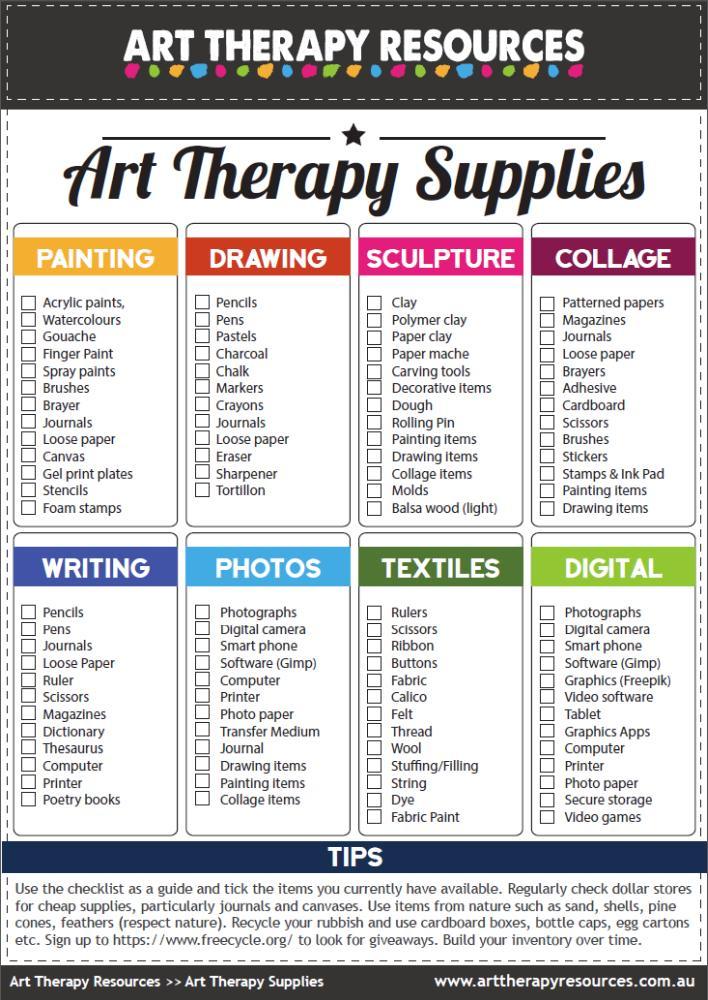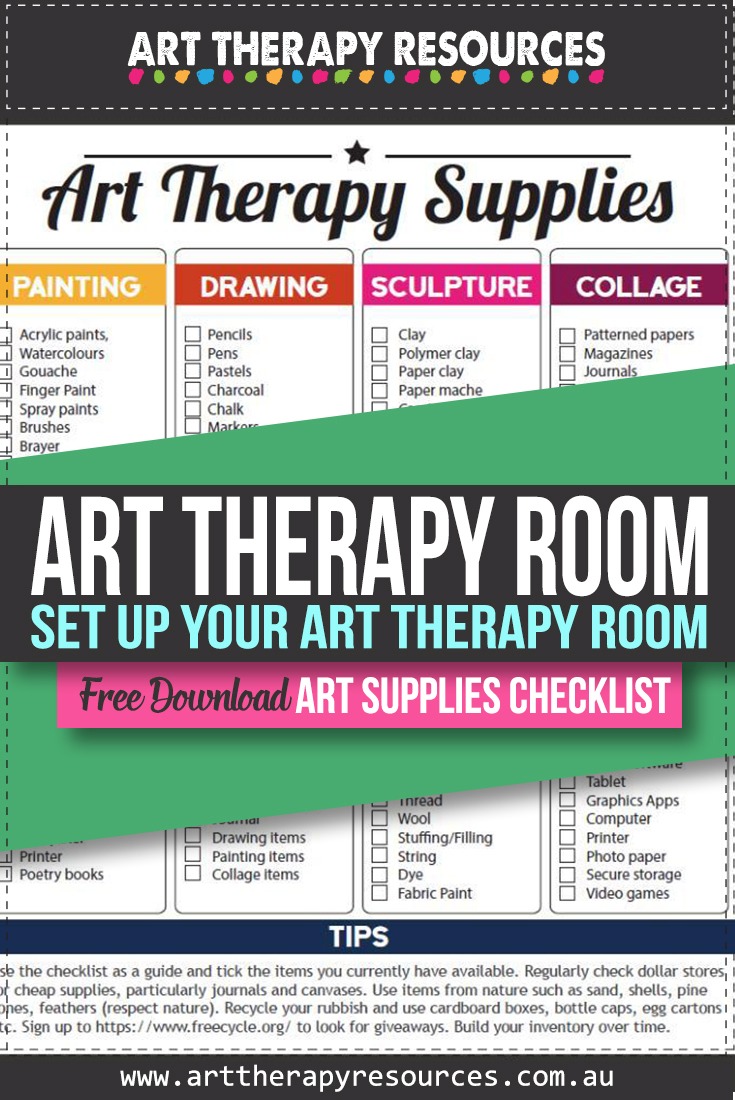THIS POST INCLUDES:
- Art Therapy Space
- Storage and Organization
- Atmosphere
- Accessibility and safety
- Studio Rules
- FREE Download Art Supplies Checklist
ART THERAPY SPACE
Establishing a functional, welcoming, and comfortable art therapy room is an integral part of providing art therapy to your clients.
A comfortable room will put your client at ease and facilitate an environment where your client is comfortable in undertaking the vulnerable process of therapy. You can create a comfortable room through colours, textures, smells, and sounds that are contained in your art therapy room.
From a functional point of view, your art therapy space should serve your purposes as well as your clients in being able to access art products, easy clean up, and allow enough space for complex projects if necessary.
Your space might also reflect who your ideal client is. If your typical clients are children, you may lean toward a more vibrant, playful art space.
Your art therapy space should provide an element of privacy so that clients feel secure enough to express their emotional experiences without feeling exposed to a high traffic area.
At a minimum, your art space should be a self-contained room that is large enough for both individual and group work. Furniture requirements typically include a sitting area for discussion as well as a creative area that contains tables, chairs, art supplies, and storage space.
If your art space also serves as your office you will want to have space for your desk, computer, and any other office equipment.
Ideally, your art therapy room should also contain a sink with running water so that clients can easily clean up after art activities. If you don’t have access to a sink, you can use larger containers of water to use as wash up buckets.
Aside from the functional aspects of an art therapy room, your art therapy room is an excellent conduit for self-expression for you as a therapist. Setting up your art therapy space is a reflection of how you value art and creativity and is an opportunity for you to invite your clients to enjoy the same art space as you. This can help build your relationship with your client as you both find trust, peace, and strength within a welcoming art space.
INDIVIDUAL AND GROUP WORK
Your art therapy room should have enough room for both individual and group work. If you don’t offer group work at this time then your art therapy room should easily accommodate at least 2-4 people. At a minimum you should have enough room for you, your client, and any parents or carers of clients.
ART THERAPY SUPPLY IDEAS
Check out our previous blog posts about art spaces and supplies to help build your knowledge on how to create your art therapy room:
- 8 Types of Art Therapy to Help Your Client
- Black and White Pens for Your Art Therapy Supplies List
- How to Create an Art Therapy Supplies Kit
- Review of Paper Substrates for Art Therapy Activities
- 10 Art Mediums To Use in Your Art Therapy Sessions
- Review of the Stabilo Pencil for Art Therapy Activities
STORAGE AND ORGANIZATION
Storage is an important part of maintaining an art therapy space. Storage means the space can be clutter free so that clients have the physical and mental space to work on their own artwork.
Storage needs to also provide an element of accessibility so that clients can easily access art supplies and start creating straight away. It is a waste of a client’s time if they have to remove boxes on boxes of containers to access the supplies they want to use. Having visually open storage also provides clients with an overview of the type of supplies they can work with. Many clients who are not familiar with art supplies may use only the supplies that are most accessible. In order to foster a degree of experimentation, it is helpful to have a variety of art supplies available for immediate use.
Storage mainly consists of:
- containers
- cupboards/drawers
- shelving
TABLES TO WORK ON
The most common furniture item in an art therapy room will be a table or desk for your client to work on.
As art usually involved paints, scissors, glue, and clay, you should expect your tables to get fairly messy. With this perspective in mind, it may not be a wise idea to use your favourite inherited table from Aunt Mary.
You might always to use lighter tables such as plastic tables. Having lightweight furniture means you can easily move tables around to suit your needs. This is particularly useful if you run group therapy sessions.
Regardless of the furniture, you use and your expectations of a mess, you can always incorporate some protection techniques including using plastic tablecloths or butcher paper. Butcher paper can later be turned into reusable artwork to use for collage or hang around your art therapy room.
TO STORE ART SUPPLIES
Some containers you can use to store supplies include:
- rolling carts
- buckets (icecream, margarine etc)
- plastic drawers/boxes
- caddys
- lockers
- hanging shoe racks
- cutlery organizers
- lazy susan
- empty tissue box
- tackle boxes
- old biscuit tins, mason jars, cookie jars, jam jars, coffee jars, lunchboxes
- baskets
- shelves
- tables
TO STORE ARTWORK
As you work with a client over time, you may accumulate a fair amount of artwork to store. Initially, the artwork may need time to dry so that you can store it away safely.
For two dimensional artworks, you can set up a drying area which may be drying racks, tables, or clothes racks with pegs. Usually the item will be dry by the end of the day so you can store away the artwork at the end of the day or the following morning.
For three dimensional artworks, you can use tables or shelves to dry items involving clay or other sculptural supplies.
For privacy and confidentiality, you can hang our store the artwork to face a wall while it is drying as other clients come into the room for their appointment.
Some therapists reduce the amount of storage required by taking photos of the artwork to digitally store in the client’s file and then letting the client take the original artwork home. This can either be done on a session by session basis or at the end of treatment.
ATMOSPHERE
In addition to creating a functional space, you can introduce other items into your space to help foster a welcoming and safe space for your clients.
Some common items you can add to your space include:
- Plants
- Inspiring images
- Inspiring quotes
- Soft furnishings (rugs, pillows)
- Sitting areas for reading, sketching, talking
- Music
- Unique lighting (see below)
Aside from adding aesthetically pleasing items to the room to make it feel more welcome, you can also engage in therapeutic rituals or traditions to begin and close an art therapy session. This could be as simple as lighting a candle, or incense, or completing a stretch to the sky to limber up the arms and open up for breathing more deeply. It could also include creating a check-in process where the client can connect with something in the room to make a statement that they are here to heal.
You will want to consider the lighting in the space as well. I personally prefer natural lighting with some soft incandescent accent lights when I am painting. Some people prefer brighter space for creating and may like a room with bright overhead lights. String lights can bring a magical ambiance to a room.
ACCESSIBILITY AND SAFETY
When setting up your art therapy room it’s important to consider the accessibility to your room for clients with disabilities. This involves thinking about stairs into your building as well as your room. You should also assess the access through your doorway and the ease of movement around the room amongst the tables, chairs and other furniture. You should also consider if your art therapy room is in a location that provides disabled parking spots or easy drop off points for clients and carers.
It’s also important to create a space that is safe for clients and encourages safe use of art supplies and tools by the client.
This is most relevant for kids who are working with tools such as scissors or other cutting and sharp instruments.
Art supplies that are used in the art room should be considered safe for use, especially for children who may transfer paint to their mouth, nose, and eyes.
The accessibility of your art therapy room will impact the likelihood of your client attending sessions. Your client may enjoy their therapy sessions, however, if getting to your art therapy room is difficult, this will impact your client’s willingness to attend therapy.
STUDIO RULES
To help keep your art therapy room well organized and functional for your clients a few rules are necessary. These rules should be displayed in the art therapy room in the form of a friendly reminder. Some common rules include returning art supplies to their original place, cleaning up any art spills, and respecting the space of other participants.
FREE DOWNLOAD: Art Supplies Checklist
SIGN up to Download the FREE art supplies checklist for a comprehensive list of items you can include in your studio.

BUILD YOUR ART THERAPY REFERENCE MATERIALS:
Pin this image to your Pinterest board.

SHARE KNOWLEDGE & PASS IT ON:
If you’ve enjoyed this post, please share it on Facebook, Twitter, Pinterest. Thank you!
